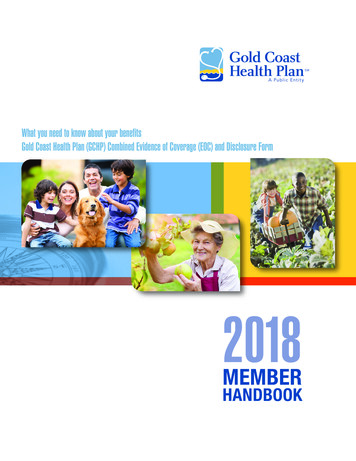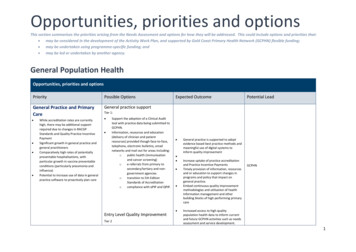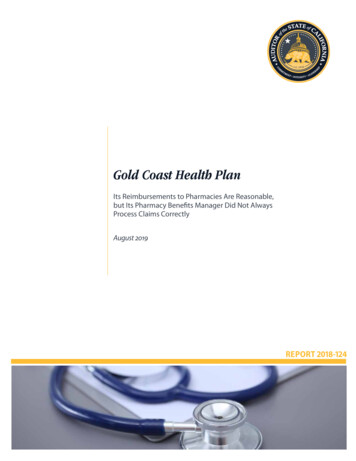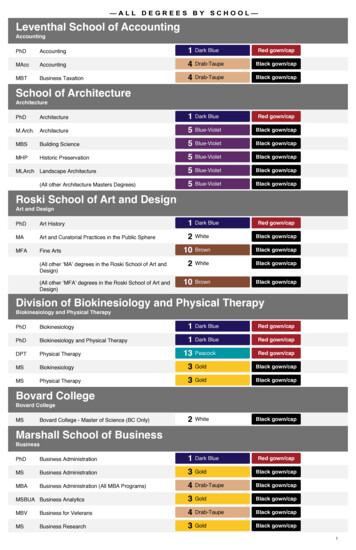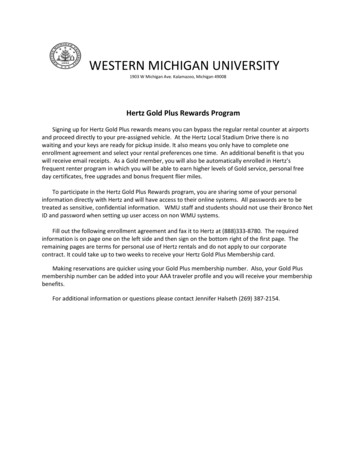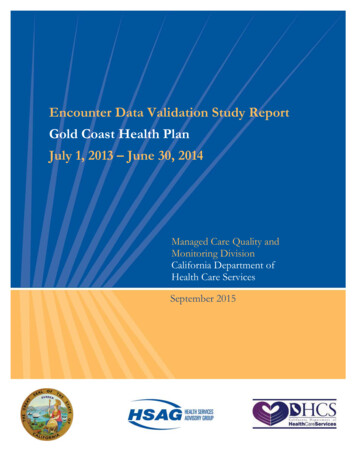
Transcription
Encounter Data Validation Study ReportGold Coast Health PlanJuly 1, 2013 – June 30, 2014Managed Care Quality andMonitoring DivisionCalifornia Department ofHealth Care ServicesSeptember 2015
SFY 2013–14 Encounter Data Validation Study Report – Gold Coast Health PlanTABLE OF CONTENTS1. OVERVIEW AND METHODOLOGY12. MEDICAL RECORD REVIEW RESULTS8OverviewMethodologyStudy PopulationSampling StrategyMedical Record ProcurementReview of Medical RecordsStudy IndicatorsMedical Record Procurement StatusEncounter Data CompletenessDate of Service CompletenessDiagnosis Code CompletenessProcedure Code CompletenessProcedure Code Modifier CompletenessRendering Provider Name CompletenessBilling Provider Name CompletenessEncounter Data AccuracyDiagnosis Code AccuracyProcedure Code AccuracyProcedure Code Modifier AccuracyRendering Provider Name AccuracyBilling Provider Name AccuracyAll-Element Accuracy3. DISCUSSIONConclusionsEncounter Data CompletenessEncounter Data AccuracyRecommendationsStudy LimitationsAPPENDIX A. PERCENTILES FOR STUDY INDICATORSGold Coast Health Plan SFY 2013–14 Encounter Data Validation Study ReportCalifornia Department of Health Care 42526A-1Page iHealth Services Advisory Group, Inc.
SFY 2013–14 Encounter Data Validation Study ReportGold Coast Health Plan1. OVERVIEW AND METHODOLOGYOverviewAccurate and complete encounter data are critical to assessing quality, monitoring programintegrity, and making financial decisions for a managed care program. Therefore, California’sMedi-Cal Managed Care program (MCMC) requires its contracted managed care health plans(MCPs) to submit high-quality encounter data. The California Department of Health Care Services(DHCS) relies on the quality of these MCP encounter data submissions to accurately andeffectively monitor and improve MCMC’s quality of care, establish appropriate performancemetrics, generate accurate and reliable reports, and obtain complete and accurate utilizationinformation. The completeness and accuracy of these data are essential to the success of DHCS’soverall management and oversight of MCMC.Beginning in State Fiscal Year (SFY) 2012–13, DHCS contracted with Health Services AdvisoryGroup, Inc. (HSAG), to conduct an Encounter Data Validation (EDV) study. During the firstcontract year, the EDV study focused on an information systems review and a comparativeanalysis between the encounter data in the DHCS data warehouse and the data in the MCPs’ datasystems. For SFY 2013–14, the goal of the EDV study was to examine the completeness andaccuracy of the encounter data submitted to DHCS by the MCPs through a review of the medicalrecords. HSAG assessed the encounter data submitted by the MCPs operating under theTwo-Plan Model (TPM—both local initiative [LI] and commercial plan [CP]), GeographicManaged Care (GMC) model, County Organized Health Systems (COHS) model, and twospecialty plans. This report is specific to Gold Coast Health Plan (Gold Coast), which delivers carein Ventura County.MethodologyMedical and clinical records are considered the “gold standard” for documenting access to and thequality of health care services. During the second contract year (SFY 2013–14), HSAG evaluatedMCMC encounter data completeness and accuracy via the review of medical records for physicianservices rendered in calendar year 2012. The study answers the following question: Are the data elements in Table 1.1 found on the professional encounters complete and accuratewhen compared to information contained within the medical records?Gold Coast Health Plan SFY 2013–14 Encounter Data Validation Study ReportCalifornia Department of Health Care ServicesPage 1Health Services Advisory Group, Inc.
OVERVIEW AND METHODOLOGYTable 1.1—Key Data Elements for Medical Record ReviewKey Data ElementDate of ServiceDiagnosis CodeProcedure CodeProcedure Code ModifierRendering Provider NameBilling Provider NameNote: Rendering Provider Name is not a data element in the DHCS encounter data.Therefore, HSAG joined the DHCS encounter data, which contain rendering provideridentification numbers, with the DHCS provider data to identify the rendering providername(s) associated with each sampled case. Additionally, as Rendering Provider Name andBilling Provider Name are not generally found in members’ medical records, results forthese elements are limited. To augment the information collected during this study, HSAGcaptured additional provider information during the procurement process in order to assessthe accuracy/completeness of the fields. However, since these elements are not directlyaccessible through the medical record review process, results from this analysis are limited.To answer the study question, HSAG conducted the following steps: Identified the eligible population and generated samples from the data extracted from the DHCSdata warehouse. Procured medical records from providers. Reviewed medical records against the submitted encounter data. Calculated study indicators.Study PopulationTo be eligible for the medical record review, a member had to be continuously enrolled in thesame county and the same MCP under the same program during the study period, and had to haveat least one professional visit during the study period. Because the MCMC enrollment of theSeniors and Persons with Disabilities (SPD) population was not completed until May 2012, thestudy period for the SPD population was from June 1, 2012, to December 31, 2012. The studyperiod for the non-SPD population was from January 1, 2012, to December 31, 2012. In thisreport, HSAG refers to “professional visits” as the services that met all criteria in Table 1.2.Table 1.2—Criteria for Professional Visits Included in the StudyData ElementCriteriaClaim TypeClaim Type “4” (Medical/Physician) in the DHCS data warehouseProvider TypeCertified nurse midwifeCertified pediatric nurse practitioner and certified family nurse practitionerClinic-otherwise undesignatedCommunity clinicsGroup certified pediatric nurse practitioner and certified family nurse practitionerGold Coast Health Plan SFY 2013–14 Encounter Data Validation Study ReportCalifornia Department of Health Care ServicesPage 2Health Services Advisory Group, Inc.
OVERVIEW AND METHODOLOGYData ElementCriteriaMulti-specialty clinicsPhysiciansPhysicians groupPodiatristsRural Health Clinics and Federally Qualified Health CentersPlace of ServiceAssisted Living FacilityEmergency Room – HospitalFederally Qualified Health CenterGroup HomeHomeIndependent ClinicOfficePublic Health ClinicRural Health ClinicUrgent Care FacilityProcedureCodeIf all detail lines for a visit had a procedure code starting with “E,” “D,” or “V,” thevisit was excluded from the study since these procedure codes are for servicesthat are outside the scope of work for this study (e.g., durable medical equipment[DME], dental, vision).Sampling StrategyHSAG used a two-stage sampling technique to select samples based on the member enrollmentand encounter data extracted from the DHCS data warehouse. HSAG first identified all SPD andnon-SPD members who met the study population eligibility criteria. Proportional randomsampling was then used to select 120 members 1 from the eligible population for each of the 53participating MCP county combinations based on the eligible population size of each MCP’s SPDand non-SPD populations. For example, if 90 percent of the eligible population in an MCP countywere non-SPD members, HSAG randomly selected 108 non-SPD members (120 * 90% 108)and 12 SPD members for a total of 120 sampled members for this MCP county. Secondly, foreach selected sampled member, HSAG used the SURVEYSELECT procedure in SAS 2 softwareto randomly select one professional visit 3 that occurred in the study period (i.e., June 1, 2012, to1The sample size 120 is based on a 90 percent confidence level, a margin of error of 6.5 percent, and a theoreticalmedical record omission rate of 25 percent.2SAS and all other SAS Institute Inc. product or service names are registered trademarks or trademarks of SASInstitute Inc. in the USA and other countries. indicates USA registration.3 To ensure that the medical record review included all services provided on the same date of service, encounters withthe same date of service and same billing and rendering provider were consolidated into one visit for samplingpurposes.Gold Coast Health Plan SFY 2013–14 Encounter Data Validation Study ReportCalifornia Department of Health Care ServicesPage 3Health Services Advisory Group, Inc.
OVERVIEW AND METHODOLOGYDecember 31, 2012, for an SPD member and January 1, 2012, to December 31, 2012, for anon-SPD member). Additionally, to evaluate whether any of the dates of service were omittedfrom the DHCS data warehouse, HSAG reviewed a second date of service rendered by the sameprovider during the review period which was closest to the selected date of service and wasselected by the provider from the medical records for each sampled member. If a sampledmember did not have a second visit with this provider during the review period, HSAG evaluatedonly one date of service for that member. As such, the final number of cases reviewed wasbetween 120 and 240 cases in total for each MCP county combination.Due to the two-stage sampling protocol, the probability of a sample case being selected wasdependent on both the distribution of an MCP’s SPD and non-SPD population as well as thedistribution of encounters for SPD and non-SPD members, and the calculation of MCP countyrates were derived using sample weights. While the distribution of SPD and non-SPD memberswas accounted for within the first stage using proportional sampling, similar adjustments forencounter distributions could not be made in advance of locating and reviewing medical records.Therefore, in order to calculate a representative rate for the overall population for each MCPcounty, HSAG assigned weights to the non-SPD and SPD rates based on the volume ofprofessional visits from the non-SPD population in calendar year 2012 and the projected volumeof professional visits from the SPD population in 2012. This method ensured that the MCPcounty results were not over- or underreported for non-SPD and SPD rates.Since an equal number of cases was selected from each MCP county to ensure an adequate samplesize when reporting rates at the MCP county level, additional adjustments were required toaggregate rates at the MCP and statewide level to account for population differences among theMCPs and MCP counties. When reporting MCP or aggregate statewide rates for the overallpopulation, the MCP counties’ raw rates were weighted according to the volume of professionalvisits among the eligible population for each MCP county. Similarly, MCP weighted rates wereused and adjusted to calculate the statewide weighted rates. This methodology ensured that noMCP county was over- or underrepresented in the MCP or statewide aggregate rates. HSAG useda similar weighting method to calculate MCP and statewide rates for the SPD population.Medical Record ProcurementPrior to initiating the medical record procurement, HSAG sent an introduction letter to each MCPoutlining the scope of the EDV study and disseminated details specific to the medical recordprocurement. The letter also announced that HSAG would be using a California-based medicalrecord procurement vendor to collect the medical records and conduct the medical record review.In addition, because the DHCS provider data did not contain provider telephone numbers, HSAGrequested each MCP to submit the provider contact information to assist with the medical recordprocurement.Gold Coast Health Plan SFY 2013–14 Encounter Data Validation Study ReportCalifornia Department of Health Care ServicesPage 4Health Services Advisory Group, Inc.
OVERVIEW AND METHODOLOGYWhen the sample was finalized, the associated date of service and service provider were identifiedfor each sampled member. For each provider identified, the procurement vendor first telephonedthe provider’s office to introduce the study, verified the correct address of the provider’s practicelocation and fax number, and obtained a contact name for the practice. The vendor then faxed astandardized record request letter explaining the purpose of the study and included both a listingof the sampled members from the provider’s practice and the required medical recorddocumentation requested. The vendor discussed the most efficient method for the provider tosupply the requested documentation—either by fax, direct upload to the vendor’s Web portal, orby arranging a convenient time to visit the site and scan the required documents directly into thevendor’s secure file transfer protocol (SFTP) site. All electronic medical records were maintainedon a secure site, which allowed the vendor’s trained certified coders to validate the cases at acentralized location under supervision and oversight. As with all medical record review andresearch activities, HSAG and its subcontracted vendors have implemented a thorough HealthInsurance Portability and Accountability Act of 1996 (HIPAA) compliance and protectionprogram in accordance with federal regulations that includes recurring training as well as policiesand procedures that address physical security, electronic security, and day-to-day operations. Basedon discussions with DHCS, HSAG did not allow providers to submit medical records via U.S.mail and worked with providers to determine an alternative method for record submission.Review of Medical RecordsConcurrent with record procurement activities, HSAG trained the vendor’s certified coding staffon specific study protocols and conducted interrater reliability and rater-to-standard testing. Allreviewers had to achieve a 95 percent accuracy rate before they were allowed to review medicalrecords and collect data for the study.During the medical record review, trained and certified coders first verified whether the sampleddate of service from the DHCS encounter data could be found in the member’s medical record. Ifso, the coders determined that the date of service was valid; if not, the coders listed the date ofservice as a medical record omission. The coders then reviewed the services provided on the selecteddate of service and validated the key data elements in Table 1.1. All findings were entered into anelectronic medical record abstraction tool to ensure data integrity.After the coders evaluated the selected date of service, they determined if the provider submittedmedical record documentation for a second date of service in the study period. If thedocumentation for a second date of service was available, the coder reviewed the servicesrendered on this date and validated the key data elements associated with the second date ofservice. If the second date of service was missing from the DHCS data warehouse, it was listed asan encounter data omission. The missing values associated with this visit were listed as an omission foreach key data element, respectively.Gold Coast Health Plan SFY 2013–14 Encounter Data Validation Study ReportCalifornia Department of Health Care ServicesPage 5Health Services Advisory Group, Inc.
OVERVIEW AND METHODOLOGYStudy IndicatorsOnce the medical record abstraction was completed, HSAG analysts exported the abstraction datafrom the electronic tool, reviewed the data, and conducted the analysis. HSAG developed fourstudy indicators to report the medical record review results: Medical record omission rate: the percentage of dates of service identified in the electronic encounterdata that were not found in the members’ medical records. HSAG also calculated this rate forthe other key data elements in Table 1.1.Encounter data omission rate: the percentage of dates of service from members’ medical records thatwere not found in the electronic encounter data. HSAG also calculated this rate for the otherkey data elements in Table 1.1.Accuracy rate of coding: the percentage of diagnosis codes, procedure codes, procedure codemodifiers, billing provider names, and rendering provider names associated with validated datesof service from the electronic encounter data that were correctly coded based on the members’medical records.Overall accuracy rate: the percentage of dates of service with all data elements coded correctlyamong all the validated dates of service from the electronic encounter data.For each study indicator, HSAG used the following schema to assign a percentile ranking to showthe performance among all MCPs with reportable rates. The 10th, 25th, 75th, and 90th percentileswere calculated based on MCPs’ rates using the UNIVARIATE procedure in SAS software.Although 24 MCPs were evaluated in the EDV study, the number of rates used to derive thepercentiles may be less than 24 because MCPs with a rate of “NA” were not included in thepercentile calculation (refer to Appendix A for the number of rates included for each studyindicator).Table 1.3—Criteria for Percentile RankingPercentileRankingStudy IndicatorRate below the 10th percentile among all MCPs withreportable rates al recordprocurement,element accuracy,or all-elementaccuracyRate at or above the 10th percentile but below the 25thpercentile among all MCPs with reportable ratesRate at or above the 25th percentile but below the 75thpercentile among all MCPs with reportable ratesRate at or above the 75th percentile but below the 90thpercentile among all MCPs with reportable rates 90thRate at or above the 90th percentile among all MCPs withreportable ratesNANo percentile ranking due to small denominator (i.e., 30)Gold Coast Health Plan SFY 2013–14 Encounter Data Validation Study ReportCalifornia Department of Health Care ServicesPage 6Health Services Advisory Group, Inc.
OVERVIEW AND METHODOLOGYPercentileRankingStudy IndicatorRate above the 90th percentile among all MCPs withreportable rates 10thRate at or below the 90th percentile but above the 75thpercentile among all MCPs with reportable cal recordomission orencounter dataomissionRate at or below the 75th percentile but above the 25thpercentile among all MCPs with reportable ratesRate at or below the 25th percentile but above the 10thpercentile among all MCPs with reportable rates 90thRate at or below the 10th percentile among all MCPs withreportable ratesNANo percentile ranking due to small denominator (i.e., 30)For the medical record omission and encounter data omission rates, lower rates represent betterperformance. Therefore, the percentile ranking criteria are different from those for the elementaccuracy and all-element accuracy rates (i.e., the percentiles were reversed when assigningpercentile ranking so that “ 90th” always represents the top 10 percent performance among theMCPs with reportable rates). Appendix A contains the values for the 10th, 25th, 75th, and 90thpercentiles for each study indicator listed in this report. Due to the skewed distribution of resultsfor certain indicators, the percentile ranking notation may differ slightly from the percentilerankings noted in Table 1.3 (i.e., 0– 25th, 25th– 75th, and 75th).Gold Coast Health Plan SFY 2013–14 Encounter Data Validation Study ReportCalifornia Department of Health Care ServicesPage 7Health Services Advisory Group, Inc.
2. MEDICAL RECORD REVIEW RESULTSfor Gold Coast Health PlanMedical Record Procurement StatusAfter identifying the sample cases, the vendor contacted the providers based on the providercontact information submitted by Gold Coast. Table 2.1 shows the medical record procurementstatus for Ventura County. With the exception of cases with valid exclusion reasons, cases withoutmedical records were included in the analysis because the encounters were submitted by GoldCoast and the members met the eligibility requirements. In addition, the cases without medicalrecords contributed to the medical record omission results in the Encounter Data Completenesssection of this report. For example, when no medical records were submitted for a sampled dateof service, all diagnosis codes associated with that date of service were treated as a medical recordomission. Therefore, if an MCP had a relatively low medical record submission rate, it wouldgenerally have a relatively high medical record omission rate for each key data rementTableRecordProcurementStatus StatusMCP/CountyInitialValidAdjustedSample Size Exclusions* Sample SizeNumber entileRankingVentura12001207965.8% 10thMCP Total12001207965.8% 10th6,360146,3464,82476.0%25th–75thStatewide Total* Although HSAG applied the criteria listed in Table 1.2 during the sampling stage, there were sample cases that did notmeet the sampling criteria based on the medical record documentation or the information collected during the recordprocurement process. Therefore, these cases were excluded from the sample. In general, the invalid samples were causedby the incorrect provider types or place of service codes associated with the encounters. For example, for certain invalidsamples, the encounter data showed “Physicians” as the provider type. After contacting the provider, however, it wasdetermined that the provider type was “DME.”Of the original sample of 120 cases, no cases were removed from the study due to theidentification of exclusion criteria in the medical record—e.g., services from DME providers,services that occurred in an inpatient setting, etc. Overall, the Gold Coast medical recordsubmission rate was 65.8 percent, which was lower than the statewide rate by 10.2 percentagepoints. Table 2.2 lists the reasons for missing medical records, with the main reasons being thatHSAG was missing rendering provider information and the inability to identify valid providerdemographic information (e.g., telephone numbers). The provider demographic information wassourced from DHCS’s encounter data or was submitted by Gold Coast for this EDV study.Gold Coast Health Plan SFY 2013–14 Encounter Data Validation Study ReportCalifornia Department of Health Care ServicesPage 8Health Services Advisory Group, Inc.
MEDICAL RECORD REVIEW RESULTSTable 2.2—Top Reasons for Missing Medical RecordsNon-Submission ReasonCountPercentMissing rendering provider information1946.3%Unable to identify valid providerdemographic information1331.7%According to the provider, member didnot access care during review period819.5%Non-responsive provider12.4%MCP Total41100.0%Note: Total may not equal 100 percent due to rounding.In addition, 24.1 percent of the procured medical records had a second date of service submittedfor validation. The relatively few submissions for a second date of service could be due to variousreasons (e.g., the member had only one visit with the same provider within the study period, theprovider did not follow the instructions to submit the second date of service, or the second dateof service submitted was outside the review period).Encounter Data CompletenessHSAG evaluated encounter data completeness by identifying differences between the electronicencounter data and the members’ medical records. Medical record omission and encounter dataomission represent two aspects of encounter data completeness. Medical record omissionsoccurred when an encounter data element (i.e., Date of Service, Diagnosis Code, or Procedure Code) wasnot supported by documentation in a member’s medical record or the medical record could not befound. Medical record omissions suggest opportunities for improvement within the provider’sinternal processes, such as billing processes and record documentation.Encounter data omissions occurred when an encounter data element (i.e., Date of Service, DiagnosisCode, or Procedure Code) was found in a member’s medical record but was not present in theelectronic encounter data. Encounter data omissions also suggest opportunities for improvementin the areas of claim and encounter submissions and/or processing routes among the providers,MCPs, and DHCS.HSAG evaluated the medical record omission rate and the encounter data omission rate using the date ofservice it selected and the additional date of service the provider selected, if one was available. Ifmore than one additional date of service in the study period was available from the medicalrecord, the provider selected the one closest to HSAG’s selected date of service. For both rates,lower values indicate better performance.Gold Coast Health Plan SFY 2013–14 Encounter Data Validation Study ReportCalifornia Department of Health Care ServicesPage 9Health Services Advisory Group, Inc.
MEDICAL RECORD REVIEW RESULTSDate of Service CompletenessTable 2.3 displays the medical record and encounter data omission rates for the data element Dateof the ofSPDandfornon-SPDdisplaystheformedicaland overallencounterdata omissionrates for thedata includeselement DateServiceGold Coast’soverallMedi-Cal Aspopulation,whichthe SPD and section,non-SPD thepopulations.in the Methodologypopulations.discussedinincludesthe Methodologyoverall Asratediscussedwas derivedfrom the SPDsection,the non-SPDoverall rate ratewas derivedfrom theweightsSPD ratebasedand non-SPDby assigningweights basedon thevolumerate andby assigningon the ratevolumeof the physicianvisitsfromeachofpopulation.the physicianThevisitsanalysesfrom teofservicelevel.conducted at the date of service level.Table 2.3—Data Element Completeness: Date of ServiceNAMedical Record OmissionDate ofServiceIdentified inElectronicEncounterDataRateVentura131MCP TotalMCP/CountyStatewide TotalEncounter Data OmissionPercentileRankingDate ofServiceIdentified inMedicalRecordsRatePercentileRanking34.9% 10th958.6%25th–75th13134.9% %25th–75thKey findings: Gold Coast’s medical record omission rate for the Date of Service data element was worse than thestatewide rate by 8.6 percentage points. The relatively high medical record omission rate for thedata element Date of Service was primarily due to finding no evidence that the date of serviceexisted in the medical records (i.e., the relatively low medical record submission rate as illustratedin Table 2.1 was a contributing factor).Compared to the medical record omission rate, the encounter data omission rate for Gold Coastwas more than 26 percentage points lower. This is partially due to relatively few medical recordswith a second date of service to validate (refer to the text below Table 2.2). The denominator forencounter data omission is the number of dates of service identified in the medical records, andthe numerator is the number of dates of service with no evidence of submission in the electronicencounter data. If no second date of service was available in the medical records for validation,then no date of service would be attributed to the numerator.Diagnosis Code CompletenessTable 2.4 displays the medical record and encounter data omission rates for the data elementDiagnosis Code for Gold Coast’s overall Medi-Cal population, which includes the SPD andnon-SPD populations. As discussed in the Methodology section, the overall rate was derived fromthe SPD rate and non-SPD rate by assigning weights based on the volume of the physician visitsfrom each population. The analyses were conducted at the diagnosis code level.Gold Coast Health Plan SFY 2013–14 Encounter Data Validation Study ReportCalifornia Department of Health Care ServicesPage 10Health Services Advisory Group, Inc.
MEDICAL RECORD REVIEW RESULTSTable 2.4—Data Element Completeness: Diagnosis CodeNAMedical Record OmissionNumber ofDiagnosesIdentified inElectronicEncounterDataRateVentura200MCP TotalMCP/CountyStatewide TotalEncounter Data OmissionPercentileRankingNumber ofDiagnosesIdentified inMedicalRecordsRatePercentileRanking42.8% 10th17834.9%25th–75th20042.8% 134.6%25th–75thKey findings: Gold Coast’s medical record omission rate for the Diagnosis Code data element was worse thanthe statewide rate by 11.2 percentage points.Gold Coast’s medical record omission rate for the Diagnosis Code data element was 7.9 percentagepoints higher than its Date of Service medical record omission rate, indicating that omission of thedates of service from medical records was the main factor contributing to the Diagnosis Codemedical record omissions. In the analysis, when no medical records were submitted for asampled date of service, all diagnosis codes associated with that date of service were treated asmedical record omissions.Gold Coast’s encounter data omission rate for the Diagnosis Code data element exceeded itsencounter data omission rate for Date of Service by more than 26 percentage points, indicatingthat the omission of dates of service from encounter data was only one factor contributing tothe Diagnosis Code encounter data omissions. Other contributing factors included the following: DHCS’s encounter data system only stores up to two diagnosis codes per encounter record.However, a physician visit using a Centers for Medicare & Medicaid Services (CMS) 1500form could contain more than two diagnosis codes. Coding errors from provider billing offices. A deficiency in Gold Coast’s data submission processes.Procedure Code CompletenessDueto toadjudicationandother anomaliesin DHCS’sdata, nd otheranomaliesin DHCS’s data,HSAG identifiedduplicateline items duplicatewith theline itemswithsame member,date of service,provider,code,and procedurecodesamemember,datetheof service,provider, procedurecode, andprocedureprocedurecode modifier.In accordancewith nationalcodingstandards,certain procedurecodes maybe submittedmore thanonceprocedurefor a given visit(e.g.,immunizationmodifier.In accord
Gold Coast Health Plan July 1, 2013 - June 30, 2014 . Managed Care Quality and Monitoring Division California Department of Health Care Services September 2015 . . non-SPD members who met he tudy population eligibility criteria . Proportional random sampling was then used to select 120 embers. 1 .
